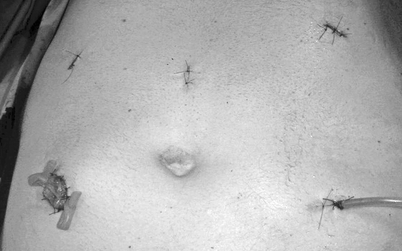Laparoscopy (n)
Laparotomy (n)
Segmental resection
23
6
Left
18
4
Right
5
1
Transverse
–
1
Anterior resection
4
1
Subtotal colectomy
–
2
Total colectomy
2
–
Ileocecal excision
–
1
The pneumoperitoneum for the reoperative surgery was performed by opening the port sites used in the first approach. The bowel was carefully managed to avoid any visceral injury. The conversion rate of the reoperative laparoscopic surgery group was 13.8 % (4 of 29). One patient required laparotomy because of ischemia in the descending colon, and another two patients were converted because of significant intestinal distention secondary to generalized peritonitis that did not permit adequate abdominal pneumoperitoneum. In 20 patients (69 %) AL was found during the reoperative laparoscopic surgery (Tables 13.2 and 13.3). Most of these cases (n = 18) were able to be managed by a rigorous abdominal lavage with the placement of an abdominal drain near the anastomotic dehiscence. This confirms that AL from the left side or after anterior resection can be readily managed by laparoscopic reoperative surgery. In three patients in whom the defect was found easily, a laparoscopic suture of the leaking anastomosis was performed. In all patients a proximal defunctioning ileostomy was fashioned where the right lower quadrant trocar was primarily placed (Fig. 13.1). One patient required a second exploration because of fecal peritonitis, resulting in a Hartmann’s operation. Between the second and third postoperative months, a contrast enema confirmed anastomotic integrity and the stoma closure was scheduled.

Complication | Laparoscopy (n = 29) | Laparotomy (n = 10) |
|---|---|---|
Anastomotic leakage | 20 (69) | 2 (20) |
Port site incisional hernia | 3 (10.3) | – |
Small bowel perforation | 2 (6.9) | 4 (40) |
Intra-abdominal bleeding | 1 (3.4) | 1 (10) |
Colocutaneous fistula | 1 (3.4) | – |
Internal hernia | 1 (3.4) | – |
No pathologic finding | 1 (3.4) | – |
Stricturoplasty dehiscence | – | 1 (10) |
Ogilvie’s syndrome | – | 1 (10) |
Adhesions | – | 1 (10) |
Findings | n | Treatment | n |
|---|---|---|---|
Anastomotic leakage | 18 | Abdominal lavage, drainage + loop ileostomy | 18 |
Port site incisional hernia | 3 | Reduction | 3 |
Anastomotic leakage + colonic ischemia | 2 | Segmentary colectomy + loop ileostomy | 2 |
Small-bowel injury | 2 | Small-bowel segmental resection, loop ileostomy | 2 |
Internal hernia | 1 | Reduction | 1 |
Colocutaneous fistula | 1 | Segmental colectomy | 1 |
Haemorrhage | 1 | Lavage | 1 |
None | 1 |

Fig. 13.1
Patient after repeat laparoscopy. Trocars were placed at the same sites used in the original surgery. The protective loop ileostomy was performed through the right quadrant incision
In three patients the persistence of severe postoperative pain at a trocar incision (umbilical, epigastric, or suprapubic) associated with significant abdominal distension motivated the second laparoscopic surgery. The finding in these patients was an acute herniation that could be easily reduced using the laparoscopic approach with fascial defect closure. Two patients required reoperative surgery because of intestinal injury, probably resulting from the lysis of adhesions from previous multiple surgeries. Although previous abdominal surgeries are not a formal contraindication for a minimally invasive approach, the adhesiolysis has to be performed carefully to avoid bowel injury. In our experience we were able to find the bowel perforation and suture it laparoscopically.
Conclusion
Although laparoscopic colorectal surgery may reduce some adverse events compared with conventional surgery, postoperative complications persist. The use of laparoscopy to perform a reoperation after an initial laparoscopy seems to be feasible in many cases and is deserving of further prospective randomized investigation, particularly when an AL occurs. In experienced hands, early adhesive small-bowel obstruction is often readily managed by a laparoscopic approach [70–74].
References
1.
Jacobs M, Verdeja JC, Goldstein HS. Minimally invasive colon resection (laparoscopic colectomy). Surg Laparosc Endosc. 1991;1:144–50.PubMed
2.
3.
Senagore AJ, Luchtefeld MA, Mackeigan JM. What is the learning curve for laparoscopic colectomy? Am Surg. 1995;61:681–5.PubMed
4.
5.
6.
7.
The Clinical Outcomes of Surgical Therapy Study Group (COST). A comparison of laparoscopically assisted and open colectomy for colon cancer. N Engl J Med. 2004;350:2050–9.CrossRef
8.
Guillou PJ, Quirke P, Thorpe H, Walker J, Jayne DG, Smith AM, Heath RM, Brown JM, MRC CLASICC trial group. Short-term endpoints of conventional versus laparoscopic-assisted surgery in patients with colorectal cancer: multicentre, randomised controlled trial. Lancet. 2005;365(9472):1718–26.PubMedCrossRef
9.
Bonjer HJ, Hop WC, Nelson H, Sargent DJ, Lacy AM, Castells A, Guillou PJ, Thorpe H, Brown J, Delgado S, Kuhrij E, Haglind E, Påhlman L, Transatlantic Laparoscopically Assisted vs Open Colectomy Trials Study Group. Laparoscopically assisted vs. open colectomy for colon cancer: a meta-analysis. Arch Surg. 2007;142:298–303.PubMedCrossRef
10.
11.
12.
13.









